A) case 1 only
B) case 2 only
C) both cases 1 and 2
D) both cases 2 and 3
E) cases 1, 2, and 3
Correct Answer

verified
Correct Answer
verified
Multiple Choice
pulls on a crate of mass m that is in contact with a rough surface. The figure shows the magnitudes and directions of the forces that act on the crate in this situation.  represents the weight of the crate.
represents the weight of the crate.  represents the normal force on the crate, and
represents the normal force on the crate, and  represents the frictional force.
represents the frictional force. 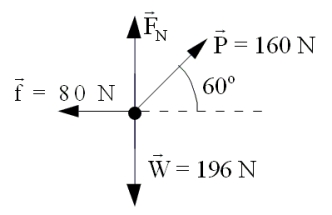 -Which statement best describes the motion of the crate?
-Which statement best describes the motion of the crate?
A) The crate must be at rest.
B) The crate must be moving with constant velocity.
C) The crate must be moving with constant acceleration.
D) The crate may be either at rest or moving with constant velocity.
E) The crate may be either at rest or moving with constant acceleration.
Correct Answer

verified
Correct Answer
verified
Multiple Choice
An object moves due east at constant speed. A net force directed due north then acts on the object for 5.0 s. At the end of the 5.0-second period, the net force drops to zero newtons. Which one of the following statements is necessarily true?
A) The object will be moving eastward when the force drops to zero newtons.
B) The change in the velocity of the object is directed north of west.
C) The direction of the object's acceleration depends on how fast the object was initially moving.
D) The final velocity of the object is directed north of east.
E) The magnitude of the object's acceleration depends on how fast the object was initially moving.
Correct Answer

verified
Correct Answer
verified
Multiple Choice
A physics student in a hot air balloon ascends vertically at constant speed. Consider the following four forces present in this situation:
 11ec874b_21ea_ddf1_a44c_811fc40246c2_TB34225555_11 1= the weight of the hot air balloon
11ec874b_21ea_ddf1_a44c_811fc40246c2_TB34225555_11 3= the force of the student pulling on the earth
11ec874b_21ea_ddf1_a44c_811fc40246c2_TB34225555_11 2= the weight of the student
11ec874b_21ea_ddf1_a44c_811fc40246c2_TB34225555_11 4= the force of the hot air balloon pulling on the student
-Which one of the following relationships concerning the forces or their magnitudes is true?
11ec874b_21ea_ddf1_a44c_811fc40246c2_TB34225555_11 1= the weight of the hot air balloon
11ec874b_21ea_ddf1_a44c_811fc40246c2_TB34225555_11 3= the force of the student pulling on the earth
11ec874b_21ea_ddf1_a44c_811fc40246c2_TB34225555_11 2= the weight of the student
11ec874b_21ea_ddf1_a44c_811fc40246c2_TB34225555_11 4= the force of the hot air balloon pulling on the student
-Which one of the following relationships concerning the forces or their magnitudes is true?
A) F4 > F2
B) F1 < F2
C) F4 > F1
D) 11ea7e4c_68b8_b189_9a0a_0f35e7ea7840_TB3413_11 2 = - 11ea7e4c_68b8_b18a_9a0a_a16584e8acce_TB3413_11 4
E) 11ea7e4c_68b8_b18b_9a0a_ff61a2306150_TB3413_11 3 = - 11ea7e4c_68b8_d89c_9a0a_63c6d9cc8ee9_TB3413_11 4
Correct Answer

verified
Correct Answer
verified
Multiple Choice
A 975-kg car accelerates from rest to 26.7 m/s in a distance of 120 m. What is the magnitude of the average net force acting on the car?
A) 740 N
B) 2900 N
C) 91 N
D) 1300 N
E) 7900 N
Correct Answer

verified
Correct Answer
verified
Multiple Choice
A massless horizontal strut is attached to the wall at the hinge O. Which one of the following phrases best describes the force that the hinge pin applies to the strut if the weight of the cables is also neglected? 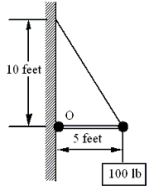
A) 50 lb, to the right
B) 100 lb, straight up
C) 200 lb, to the right
D) 244 lb, 27° above the strut
E) 56 lb, to the left
Correct Answer

verified
Correct Answer
verified
Multiple Choice
What is the weight of a 2.50-kg bag of sand on the surface of the earth?
A) 2.50 N
B) 9.80 N
C) 24.5 N
D) 49.0 N
E) 98.0 N
Correct Answer

verified
Correct Answer
verified
Multiple Choice
A 20.0-kg package is dropped from a high tower in still air and is "tracked" by a radar system. When the package is 25 m above the ground, the radar tracking indicates that its acceleration is 7.0 m/s2. Determine the force of air resistance on the package.
A) 56 N
B) 28 N
C) 280 N
D) 196 N
E) 140 N
Correct Answer

verified
Correct Answer
verified
Multiple Choice
Two identical blocks are pulled along a rough surface as suggested in the figure. Which one of the following statements is false? 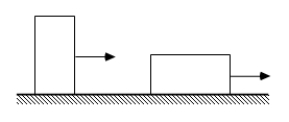
A) The coefficient of kinetic friction is the same in each case.
B) A force of the same magnitude is needed to keep each block moving.
C) A force of the same magnitude was required to start each block moving.
D) The normal force exerted on the blocks by the surface is the same for both blocks.
E) The magnitude of the force of kinetic friction is greater for the block on the right.
Correct Answer

verified
Correct Answer
verified
Multiple Choice
A rock is suspended from a string and moves downward at constant speed. Which statement is true concerning the tension in the string if air resistance is ignored?
A) The tension is zero newtons.
B) The tension points downward.
C) The tension is equal to the weight of the rock.
D) The tension is less than the weight of the rock.
E) The tension is greater than the weight of the rock.
Correct Answer

verified
Correct Answer
verified
Multiple Choice
A muscle builder holds the ends of a massless rope. At the center of the rope, a 7.9-kg ball is hung as shown. What is the tension in the rope if the angle in the drawing is 6.0°? 
A) 960 N
B) 740 N
C) 370 N
D) 230 N
E) 150 N
Correct Answer

verified
Correct Answer
verified
Multiple Choice
A 2.0-N rock slides on a frictionless inclined plane. Which one of the following statements is true concerning the normal force that the plane exerts on the rock? 
A) The normal force is zero newtons.
B) The normal force is 2.0 N.
C) The normal force is less than 2.0 N, but greater than zero newtons.
D) The normal force is greater than 2.0 N.
E) It increases as the angle of inclination, , is increased.
Correct Answer

verified
Correct Answer
verified
Multiple Choice
A block of weight W is suspended by a string of fixed length. The ends of the string are held at various positions as shown in the figures below. In which case, if any, is the magnitude of the tension along the string the largest? 
A) case A
B) case B
C) case C
D) case D
E) The magnitude of the tension will be the same in all four cases, since the string must support the entire weight of the block.
Correct Answer

verified
Correct Answer
verified
Multiple Choice
Two forces act on a hockey puck. For which orientation of the forces will the puck acquire an acceleration with the largest magnitude?
A) ![]()
B) ![]()
C) ![]()
D) ![]()
E) The magnitude of the acceleration will be the same in all four cases shown above.
Correct Answer

verified
Correct Answer
verified
Multiple Choice
Consider the following forces. (1) frictional (2) gravitational (3) tension (4) strong nuclear (5) normal (6) electroweak Which of the forces listed are considered fundamental forces?
A) 1, 2, and 4
B) 1, 2, 3, and 5
C) 1, 3, and 5
D) 2, 4, and 6
E) 2, 3, 4, and 6
Correct Answer

verified
Correct Answer
verified
Multiple Choice
A block is at rest on a rough inclined plane and is connected to an object with the same mass as shown. The rope may be considered massless; and the pulley may be considered frictionless. The coefficient of static friction between the block and the plane is μs; and the coefficient of kinetic friction is μk.
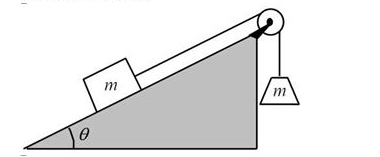 -If the mass of the suspended object is doubled, what will be the acceleration of the block up the plane?
-If the mass of the suspended object is doubled, what will be the acceleration of the block up the plane?
A) g(2 - k sin )
B) 2g( k sin - cos )
C) g(2tan - k sin )
D) g(2 - sin - k cos )
E) g(2cos - k sin )
Correct Answer

verified
Correct Answer
verified
Multiple Choice
Complete the following statement: An inertial reference frame is one in which
A) Newton's first law of motion is valid.
B) the inertias of objects within the frame are zero.
C) the frame is accelerating.
D) the acceleration due to gravity is greater than zero m/s2.
E) Newton's second law of motion is not valid.
Correct Answer

verified
Correct Answer
verified
Multiple Choice
What is the tension in the right-hand cable?
A) 87 N
B) 150 N
C) 170 N
D) 260 N
E) 300 N
Correct Answer

verified
Correct Answer
verified
Multiple Choice
A rock is thrown straight up from the earth's surface. Which one of the following statements concerning the net force acting on the rock at the top of its path is true?
A) The net force is equal to the weight of the rock.
B) The net force is instantaneously equal to zero newtons.
C) The direction of the net force changes from up to down.
D) The net force is greater than the weight of the rock.
E) The net force is less than the weight of the rock, but greater than zero newtons.
Correct Answer

verified
Correct Answer
verified
Multiple Choice
Two blocks rest on a horizontal frictionless surface as shown. The surface between the top and bottom blocks is roughened so that there is no slipping between the two blocks. A 30-N force is applied to the bottom block as suggested in the figure. 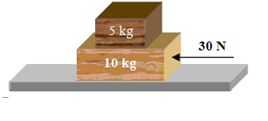 -What is the acceleration of the "two block" system?
-What is the acceleration of the "two block" system?
A) 1 m/s2
B) 2 m/s2
C) 3 m/s2
D) 6 m/s2
E) 15 m/s2
Correct Answer

verified
Correct Answer
verified
Showing 81 - 100 of 103
Related Exams